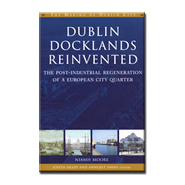Posted: 28 April 2008
Dublin docklands – the regeneration of a European city quarter
Over the past two decades, the redevelopment of the Dublin docklands has radically altered the physical fibre and social structure of a significant part of Dublin city, north and south of the river. There are many international parallels that can be drawn between this redevelopment and those which took place in New York, London and Sydney.
In a new book, Dublin Docklands Reinvented, Dr Niamh Moore from the UCD School of Geography, Planning and Environmental Policy, examines how global urban influences have interacted with local processes to transform a once marginal part of Dublin city into an economically successful and vibrant urban quarter.
“Dublin docklands has become a cornerstone of the city that embodies the rapid restructuring that has been experienced in Ireland over the last twenty years,” says Dr Moore. “Large tracts of derelict and depressed environments in the inner city have been completely transformed.”
“In a comparative study of cities by Peter Taylor in 2003, Dublin was ranked as the fifth most important European city in relation to its network or gateway power, and the twelfth most important network city in global terms. The development of this profile has been largely facilitated by the growth of International Fund Services activities in Dublin, most of which are based in the docklands,” explains Dr Moore.
According to Dr Moore, the Dublin docklands regeneration may, in general terms, be rated as a significant success but the evolution of the project was fraught with difficulties and tensions, particularly between the many different groups that have a stake in the future of the area.
“In the early 1970s and in 1980, redevelopment plans by the Dublin Port and Docks Board were rejected by a wide range of agencies and groups,” says Dr Moore. “In fact, they were condemned as representing an attempt to develop opportunistically an area without adequate consideration for the surrounding communities and districts.”
“Yet a very different kind of optimism became evident just a few years later as the area became embroiled in the controversial Gregory Deal,” she says. “In 1982 the decision to nationalise the Custom House Docks as part of the Gregory Deal was criticised by the Dublin Port and Docks Board, who clashed with central government over the inadequate compensation they received when the site was compulsorily taken from them.”
In Dublin Docklands Reinvented, published by Four Courts Press, Dr Moore places significance on the politics of redevelopment and the role of particular individuals in re-shaping the Dublin docklands. In a detailed up-to-date account of the changes that have taken place in the docklands, the book highlights some of the difficulties encountered by a number of agencies along the way, including the controversy over the redevelopment of Spencer Dock, the problems of contamination at the Grand Canal Dock and the future challenges of regenerating the Poolbeg Peninsula.
Dr Niamh Moore is a lecturer and university fellow in teaching and academic development at the UCD School of Geography, Planning and Environmental Policy.

